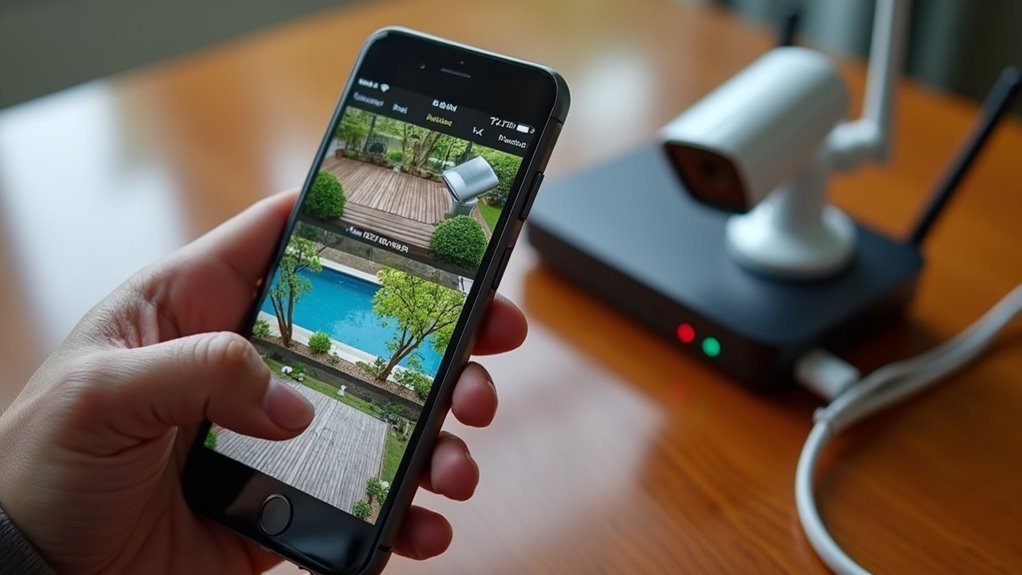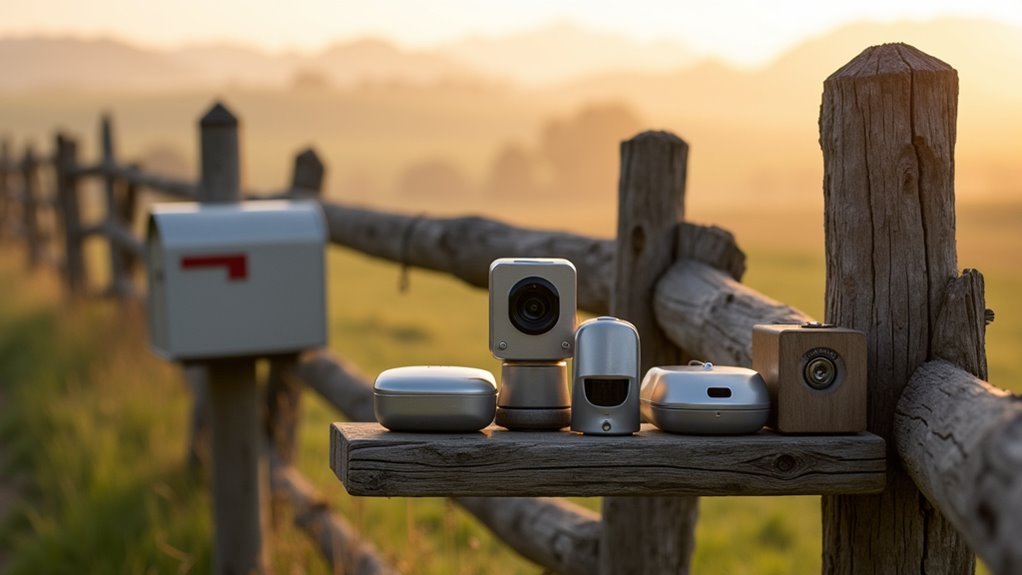You’re probably tired of motion sensors that miss subtle movements or trigger false alarms every time a curtain flutters. Traditional PIR sensors simply can’t match the precision of mmwave radar technology, which detects even the slightest breathing motions through walls and in complete darkness. With an LD2410 sensor and ESP32 board costing under $15 total, you can build a presence detector that’ll revolutionize your home automation—but only if you configure it correctly.
Understanding Mmwave Technology and Its Advantages

While traditional motion sensors rely on detecting heat signatures, mmWave radar technology revolutionizes presence detection by operating within the 30-300 GHz frequency range to sense even the subtlest human movements.
You’ll find mmWave sensors offer enhanced sensitivity that detects breathing and heartbeats, making them superior to PIR sensors for Human Presence Sensor applications.
Unlike infrared detectors, you can use these sensors effectively in low-light conditions or environments with obstacles since they employ radar technology.
You’ll appreciate their ability to distinguish between different movement patterns, providing accurate presence detection even when someone’s stationary.
The adjustable sensitivity settings let you customize detection parameters, reducing false positives from pets or environmental factors while maintaining reliable human detection.
Essential Components and Cost Breakdown
Building your own mmWave radar presence detector requires just three core components that’ll cost you under $10.
The HiLink LD2410 sensor serves as your mmWave presence sensor, priced at $4.31. This specialized detector outperforms traditional PIR sensors with superior sensitivity for human presence detection, making it perfect for automated lighting systems.
At just $4.31, the HiLink LD2410 delivers superior human presence detection compared to traditional PIR sensors.
You’ll need a Lolin D1 Mini v4 ESP8266 microcontroller ($3.96) to process the LD2410 sensor data and provide Wi-Fi connectivity for smart home integration.
The final component is 1.25mm to 2.54 connectors ($0.71) for proper wiring connections.
This $9.98 total represents a 94% cost savings compared to commercial alternatives like the $36 Aqara FP2.
You might need basic soldering equipment and Dupont wires, adding minimal costs.
Choosing Between LD2410 and Other Sensor Options

When you’re selecting a mmWave presence detector, you’ll need to evaluate the LD2410’s technical capabilities against competing sensors like the Aqara FP2 and RCWL-0516.
The LD2410 stands out for detecting both motion and stationary presence while offering built-in Bluetooth configuration at a fraction of premium alternatives’ cost.
You’ll want to analyze how each sensor’s specifications, performance features, and price point align with your specific automation requirements.
LD2410 Technical Specifications
The LD2410’s impressive technical capabilities set it apart from conventional motion detection solutions in several key areas.
This mmWave radar sensor operates at 24GHz frequency, delivering superior reliability compared to traditional PIR sensors. You’ll get a detection range of 5-10 meters with remarkable sensitivity that can detect subtle movements like breathing.
The sensor excels at presence detection by simultaneously monitoring multiple individuals, something standard motion sensors struggle with.
You can customize sensitivity settings to match your specific environmental conditions and requirements.
The LD2410C variant adds Bluetooth connectivity, letting you configure the device easily through your mobile phone.
This combination of advanced radar technology, flexible settings, and wireless configuration makes the LD2410 ideal for sophisticated presence detection applications.
Alternative Sensor Comparisons
While several presence detection sensors compete for your attention, understanding their key differences will help you make an informed choice. The LD2410 mmWave sensor stands out for its exceptional motion detection capabilities and cost-effectiveness.
| Feature | LD2410 | Aqara FP2 | HiLink LD2450 |
|---|---|---|---|
| Cost | ~$10 | ~$39.99 | ~$15 |
| Sensitivity Tuning | Fully customizable | Limited | Basic |
| Special Features | Heart rate monitoring, multi-person detection | Enhanced automation | Standard mmWave |
You’ll find the LD2410 detects stationary subjects and subtle movements that traditional PIR sensors miss. Its customizable sensitivity settings let you reduce false positives while maintaining accurate detection. Unlike pricier alternatives, you’re getting professional-grade presence detection without breaking your budget, making it ideal for DIY home automation projects.
Cost Performance Analysis
At just $4.31, the LD2410 delivers exceptional value that’s hard to ignore when building your presence detection system.
This cost performance analysis reveals why this radar sensor outshines expensive alternatives while maintaining superior functionality.
You’ll save approximately 60% compared to the Apollo MSR2 and even more against premium options like the Aqara FP2 at $36.
Your DIY setup costs roughly $13 per unit versus $29+ for pre-built solutions.
- Breathing Detection: Catches subtle movements that PIR sensors miss completely
- 60% Savings: Significant cost reduction compared to Apollo MSR2 alternatives
- DIY Value: Complete setup under $13 versus $29+ commercial options
- Community Validated: User feedback confirms performance rivals expensive competitors
You’re getting professional-grade presence detection without the premium price tag.
Preparing Your ESP32 Development Board

Before diving into the radar sensor integration, you’ll need to prepare your ESP32 development board with the essential components and software setup.
Start by gathering your ESP32 Board, LD2410C sensor, USB to Serial adapter, and necessary wiring tools like Dupont wires and a soldering station.
Connect your ESP32 Board to a USB power source and verify it’s functioning by checking the LED indicators.
Connect your ESP32 to USB power and confirm proper operation by observing the onboard LED status indicators.
Next, install the required drivers and Arduino IDE or PlatformIO on your computer to enable communication with your development board.
Configure your setup process by selecting the correct COM port and setting the appropriate baud rate to match the LD2410C sensor specifications.
Finally, prepare ESPHome firmware to upload configuration files that’ll enable effective sensor communication and presence detection data processing.
Wiring the Mmwave Sensor to ESP32
Once your ESP32 development board is ready, you’ll establish the essential hardware connections between your board and the LD2410C mmWave sensor. This wiring process guarantees proper power delivery and serial communication for accurate presence detection.
- Power connections: Connect the sensor’s VCC pin to the ESP32’s 5V (VIN) pin and ground to ground for adequate power supply.
- Serial communication setup: Cross-connect the LD2410’s TX pin to GPIO 16 and RX pin to GPIO 17 on your ESP32.
- Secure wiring: Use Dupont wires to create firm connections between all pins, preventing intermittent failures during operation.
- Connection verification: Upload a test sketch to your ESP32 and monitor the serial output to confirm the sensor’s data transmission.
Flashing ESPHome Firmware
Your ESP32 needs ESPHome firmware installed before you connect the LD2410 sensor to guarantee proper communication between components.
You’ll want to handle the initial firmware flash first, then set up the hardware connections afterward to avoid any UART port conflicts.
Once you’ve got the base firmware running, you can use OTA updates to push configuration changes and improvements without physically accessing the device.
Pre-Flash Hardware Setup
To guarantee successful firmware flashing, you’ll need to establish the proper hardware connections between your Lolin D1 Mini v4 ESP8266 and USB to Serial Adapter. This pre-flash hardware setup guarantees reliable communication during the firmware installation process.
Your USB to Serial Adapter must operate at 5V to effectively power the LD2410 sensor. However, you’ll need to disconnect the LD2410 from the adapter during flashing to prevent communication failures on shared UART ports.
- Connect your D1 Mini to the USB to Serial Adapter with proper wiring
- Confirm the adapter operates at 5V for adequate sensor power supply
- Temporarily disconnect the LD2410 sensor before initiating firmware flash
- Verify all connections are secure before proceeding with ESPHome installation
OTA Update Process
After completing your initial hardware setup and successfully flashing the firmware via USB connection, you’ll want to leverage ESPHome’s Over-The-Air (OTA) update capability for all future firmware modifications. This streamlined ota update process eliminates the need to physically connect your radar presence detector for subsequent updates.
| Step | Action |
|---|---|
| 1 | Confirm ESP device connects to same Wi-Fi network |
| 2 | Open ESPHome dashboard and select your radar device |
| 3 | Monitor update progress through ESPHome logs |
| 4 | Restart device after successful firmware installation |
During the OTA update, you’ll upload new firmware wirelessly through the ESPHome dashboard. Watch the logs carefully to catch any potential errors. Once complete, restart your radar presence detector to apply changes and verify functionality through the ESPHome interface.
Configuring Sensitivity Settings and Detection Zones
While the LD2410 mmWave sensor delivers impressive detection capabilities out of the box, you’ll achieve peak performance by fine-tuning its sensitivity settings and detection zones to match your specific environment.
Access Engineering mode to configure sensitivity values between 0-100 for both moving and stationary subjects. This customization optimizes detection thresholds based on your room’s unique characteristics.
You can also adjust the unmanned duration to 20 seconds, preventing false positives when you briefly remain still.
- Use the LD2410 Web Configurator to visualize real-time sensor data and monitor detection patterns
- Create custom sensitivity zones that respond accurately to human presence while ignoring environmental factors
- Adjust detection zones dynamically based on proximity to optimize coverage areas
- Fine-tune settings to minimize false triggers from moving fans or other environmental disturbances
Integrating With Home Assistant
Once you’ve optimized your sensor’s performance through proper configuration, Home Assistant integration transforms your mmWave radar detector into a powerful automation hub.
You’ll use ESPHome firmware to configure your ESP32 device and define your LD2410 radar sensor’s parameters. Verify you’ve set the correct baud rate and COM port settings for seamless communication.
ESPHome’s built-in MQTT functionality publishes your sensor’s state to Home Assistant, enabling real-time updates for motion detection.
Create automation rules that trigger actions like lighting control or notifications based on presence data. You’ll access sensitivity adjustments directly through Home Assistant’s interface, allowing you to minimize false positives and customize detection responsiveness for your specific environment.
Troubleshooting Common Issues and False Positives
Even with proper Home Assistant integration, your mmWave radar detector may trigger unexpectedly due to environmental factors beyond your initial configuration.
Environmental interference can cause mmWave sensors to produce false triggers even when Home Assistant is correctly configured and calibrated.
False positives can frustrate your smart home automation, but you can minimize them through strategic adjustments.
- Relocate away from reflective surfaces – Move your sensor from areas near mirrors, glass doors, or metal objects that bounce radar signals and create phantom motion detection.
- Fine-tune sensitivity settings – Access engineering mode to reduce detection sensitivity, preventing activation from pets, air currents, or subtle vibrations.
- Configure unmanned delay timers – Set longer delays before activation to account for brief stillness periods during normal occupancy.
- Monitor output data patterns – Use visualization tools to track false activations and identify ideal positioning or sensitivity configurations.
Advanced Tuning and Optimization Techniques
After resolving basic false positives, you can access your LD2410 sensor’s full potential through advanced calibration techniques that transform detection accuracy.
Enable Engineering mode for precise sensitivity modifications with real-time Home Assistant feedback. Adjust moving and static object thresholds between 0-100, experimenting systematically to find ideal settings for your environment.
Set unmanned duration to approximately 20 seconds, preventing false triggers from brief stillness periods. This proves especially vital in rooms with ceiling fans or other motion sources.
Leverage Signal-to-Noise Ratio readings during sensor placement to minimize interference from non-human movements.
Continuously test different sensitivity configurations across various environmental conditions. Document successful settings for different scenarios.
This methodical approach enhances your automation reliability and creates sophisticated presence detection that responds accurately to human occupancy while ignoring irrelevant sensors feedback.
Frequently Asked Questions
Can Mmwave Radar Presence Detectors Work Through Walls or Glass Barriers?
You’ll find mmwave radar can penetrate thin drywall and glass windows effectively, but thick concrete or metal barriers greatly reduce signal strength. Detection accuracy decreases through most solid materials, limiting reliable presence sensing capabilities.
How Much Power Does a Mmwave Presence Detector Consume During Operation?
You’ll find mmwave presence detectors consume very low power, typically 0.5-3 watts during active operation. They’re designed for continuous monitoring while maintaining energy efficiency, making them suitable for battery-powered applications.
Are There Privacy Concerns With Mmwave Radar Detecting Human Presence?
You don’t face significant privacy concerns since mmwave radar only detects movement and presence without capturing images or identifying individuals. It can’t see through walls or record personal data.
What Is the Typical Lifespan of Mmwave Radar Sensors?
You’ll find mmwave radar sensors typically last 10-15 years with proper installation and maintenance. They’re highly durable since they don’t have moving parts, but environmental factors can affect their longevity.
Can Multiple Mmwave Detectors Interfere With Each Other in Same Room?
Yes, you’ll experience interference when multiple mmwave detectors operate in the same room. They can create false readings, reduced sensitivity, and detection errors. You should space them apart or use different frequency bands.





Leave a Reply